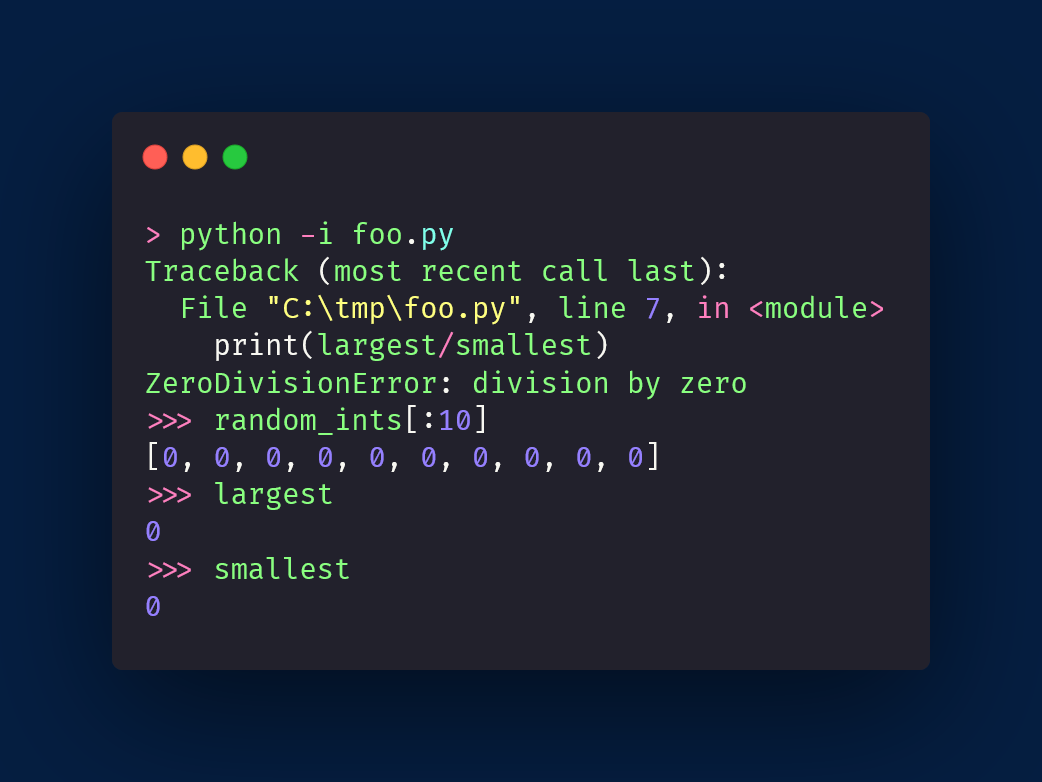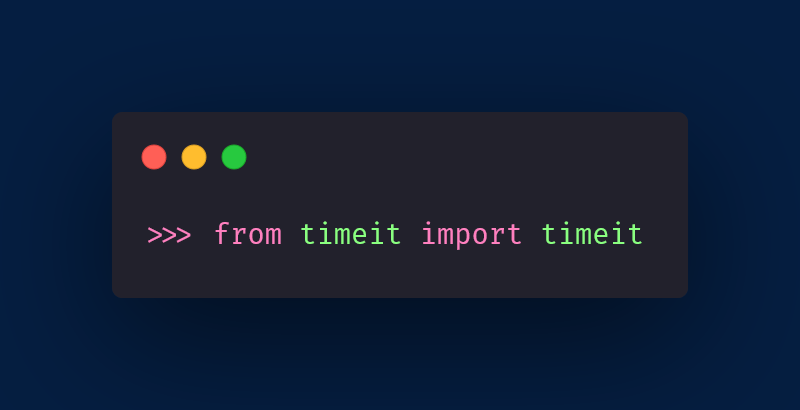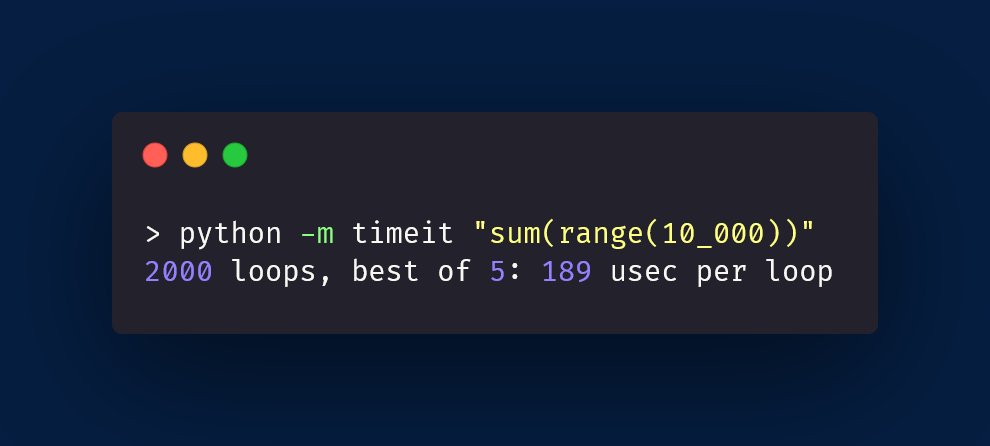
🤔 Do you ever write some Python 🐍, look at it, and get the feeling there MUST be a better ✨ way to do that..?
I get that ALL the time! 😅
That's why I started researching and writing articles to help me (and you!) write better code.
Here's all 28 of them (so far!) 👇🧵
I get that ALL the time! 😅
That's why I started researching and writing articles to help me (and you!) write better code.
Here's all 28 of them (so far!) 👇🧵
I have also been compiling all the articles into an eBook 📖, that I am "selling" for free 💸.
Why?
I decided to make it free because that's how I learned Python: from free books and articles, available online.
Here's the link to the free book:
gum.co/pydonts
Why?
I decided to make it free because that's how I learned Python: from free books and articles, available online.
Here's the link to the free book:
gum.co/pydonts
01 - Pydon't disrespect the Zen of Python
If you type `import this` in a Python REPL, you will be presented with the Zen of Python, a document with some guidelines that you can follow when writing code.
It's not a religion!
Just some guidelines :)
mathspp.com/blog/pydonts/p…
If you type `import this` in a Python REPL, you will be presented with the Zen of Python, a document with some guidelines that you can follow when writing code.
It's not a religion!
Just some guidelines :)
mathspp.com/blog/pydonts/p…
02 – Unpacking with starred assignments
This article shows you how to use the star `*` in multiple assignments to extract portions of iterables that you may be interested in.
mathspp.com/blog/pydonts/u…
This article shows you how to use the star `*` in multiple assignments to extract portions of iterables that you may be interested in.
mathspp.com/blog/pydonts/u…
03 – EAFP and LBYL coding styles
In Python, we have `try: ... except: ...` blocks, and it is often considered idiomatic Python code to use them (EAFP) instead of using pre-emptive checks with `if` statements (LBYL).
Here's a look at these two styles:
mathspp.com/blog/pydonts/e…
In Python, we have `try: ... except: ...` blocks, and it is often considered idiomatic Python code to use them (EAFP) instead of using pre-emptive checks with `if` statements (LBYL).
Here's a look at these two styles:
mathspp.com/blog/pydonts/e…
04 – Assignment expressions and the walrus operator
The walrus operator `:=` was introduced in Python 3.8.
This article teaches you its behaviour and then presents some interesting use cases for it.
mathspp.com/blog/pydonts/a…
The walrus operator `:=` was introduced in Python 3.8.
This article teaches you its behaviour and then presents some interesting use cases for it.
mathspp.com/blog/pydonts/a…
05 – `str` and `repr`
The two built-in functions `str` and `repr` are closely related, and sometimes people don't even know about `repr`!
Or they do know about `repr`, but have no idea what it's for!
This article takes care of that 😊
mathspp.com/blog/pydonts/s…
The two built-in functions `str` and `repr` are closely related, and sometimes people don't even know about `repr`!
Or they do know about `repr`, but have no idea what it's for!
This article takes care of that 😊
mathspp.com/blog/pydonts/s…
06 – Truthy, Falsy, and `bool`
This article goes deep into one of my favourite vanilla Python features: the Truthy and Falsy values of objects.
Knowing how to use this enables you to use some very idiomatic patterns.
mathspp.com/blog/pydonts/t…
This article goes deep into one of my favourite vanilla Python features: the Truthy and Falsy values of objects.
Knowing how to use this enables you to use some very idiomatic patterns.
mathspp.com/blog/pydonts/t…
07 – Watch our for recursion
As a mathematician, I find recursion very elegant.
Often, solutions to problems present themselves as recursive solutions.
However, there are some gotchas to using recursion in Python. That's what I cover in this article.
mathspp.com/blog/pydonts/w…
As a mathematician, I find recursion very elegant.
Often, solutions to problems present themselves as recursive solutions.
However, there are some gotchas to using recursion in Python. That's what I cover in this article.
mathspp.com/blog/pydonts/w…
08 – Deep unpacking
This feature deals with the structure of things like lists and tuples, and allows for some really neat code.
This is also a feature you should know, in order to make the most of the `match` statement coming in Python 3.10!
mathspp.com/blog/pydonts/d…
This feature deals with the structure of things like lists and tuples, and allows for some really neat code.
This is also a feature you should know, in order to make the most of the `match` statement coming in Python 3.10!
mathspp.com/blog/pydonts/d…
09 – Chaining comparison operators
Another neat thing about Python that I haven't seen in many other languages (actually, off the top of my head, I can't recall _any_).
When doing some comparisons, you can actually chain them, here's how/when/why:
mathspp.com/blog/pydonts/c…
Another neat thing about Python that I haven't seen in many other languages (actually, off the top of my head, I can't recall _any_).
When doing some comparisons, you can actually chain them, here's how/when/why:
mathspp.com/blog/pydonts/c…
10 – Structural pattern matching tutorial
Here's most of what there is to know about the `match` statement that is coming to Python in version 3.10.
This article shows the syntax and some great use cases.
mathspp.com/blog/pydonts/s…
Here's most of what there is to know about the `match` statement that is coming to Python in version 3.10.
This article shows the syntax and some great use cases.
mathspp.com/blog/pydonts/s…
11 – Structural pattern matching anti-patterns
Even though `match` has great potential, I can foresee some people will go bananas and start using it everywhere.
This article covers some situations where `match` _could_ be used, but probably shouldn't:
mathspp.com/blog/pydonts/s…
Even though `match` has great potential, I can foresee some people will go bananas and start using it everywhere.
This article covers some situations where `match` _could_ be used, but probably shouldn't:
mathspp.com/blog/pydonts/s…
12 – Zip up
Python's `for` loops are AMAZING.
Like, hands down, beautiful.
If you know what you are doing, `for` loops can be read as English sentences.
For that to happen, you must know about `zip`, one of my favourite built-in functions.
mathspp.com/blog/pydonts/z…
Python's `for` loops are AMAZING.
Like, hands down, beautiful.
If you know what you are doing, `for` loops can be read as English sentences.
For that to happen, you must know about `zip`, one of my favourite built-in functions.
mathspp.com/blog/pydonts/z…
13 – Enumerate me
Along the same lines, `enumerate` is another fabulous built-in function that you will wish you had known from day 1.
Probably, one of the built-in functions I use the most in my Python code!
mathspp.com/blog/pydonts/e…
Along the same lines, `enumerate` is another fabulous built-in function that you will wish you had known from day 1.
Probably, one of the built-in functions I use the most in my Python code!
mathspp.com/blog/pydonts/e…
14 – Sequence indexing
This article sets up the stage for a 3-part "series" on slicing.
This article reintroduces indexing syntax and shows some diagrams to get you comfortable with negative indexing, a Python super power.
mathspp.com/blog/pydonts/s…
This article sets up the stage for a 3-part "series" on slicing.
This article reintroduces indexing syntax and shows some diagrams to get you comfortable with negative indexing, a Python super power.
mathspp.com/blog/pydonts/s…
15 – Idiomatic sequence slicing
Part 1/3 introduces slicing syntax and draws parallels between slicing and indexing with a `for` loop.
It also introduces four idiomatic slicing patterns you should be comfortable with.
mathspp.com/blog/pydonts/i…
Part 1/3 introduces slicing syntax and draws parallels between slicing and indexing with a `for` loop.
It also introduces four idiomatic slicing patterns you should be comfortable with.
mathspp.com/blog/pydonts/i…
16 – Mastering sequence slicing
Part 2/3 covers more advanced stuff, like
- using negative steps;
- assigning directly to slices; and
- deleting slices.
mathspp.com/blog/pydonts/m…
Part 2/3 covers more advanced stuff, like
- using negative steps;
- assigning directly to slices; and
- deleting slices.
mathspp.com/blog/pydonts/m…
17 – Inner workings of sequence slicing
In part 3/3 we look under the hood, and understand how Python slices objects.
We learn about the built-in `slice` and some dunder methods, like `__getitem__`.
We also see how to implement slicing for yourself.
mathspp.com/blog/pydonts/m…
In part 3/3 we look under the hood, and understand how Python slices objects.
We learn about the built-in `slice` and some dunder methods, like `__getitem__`.
We also see how to implement slicing for yourself.
mathspp.com/blog/pydonts/m…
18 – Boolean short-circuiting
Boolean short-circuiting allows you to write long(er) conditions where some parts may not even get evaluated.
This may sound weird, but has some powerful usages!
mathspp.com/blog/pydonts/b…
Boolean short-circuiting allows you to write long(er) conditions where some parts may not even get evaluated.
This may sound weird, but has some powerful usages!
mathspp.com/blog/pydonts/b…
19 – The power of `reduce`
`reduce` used to be a built-in function, but was relegated to the module `functools` in Python 3.
What many fail to realise, is that `reduce` is what drives many built-ins like `sum`, `all`, `any`, `max`, and `min`.
mathspp.com/blog/pydonts/t…
`reduce` used to be a built-in function, but was relegated to the module `functools` in Python 3.
What many fail to realise, is that `reduce` is what drives many built-ins like `sum`, `all`, `any`, `max`, and `min`.
mathspp.com/blog/pydonts/t…
20 – Usages of underscore
From making your numbers more readable, ...
to marking “magic” methods and attributes, ...
to storing lost REPL values;
the underscore is a low-key character that sure is handy!
Here's everything I could find about it:
mathspp.com/blog/pydonts/u…
From making your numbers more readable, ...
to marking “magic” methods and attributes, ...
to storing lost REPL values;
the underscore is a low-key character that sure is handy!
Here's everything I could find about it:
mathspp.com/blog/pydonts/u…
21 – `__name__` dunder attribute
The dunder attribute `__name__` often shows up in the form of
```
if __name__ == "__main__":
...
```
but there is more to it than you might know!
No worries, I did all the research, you can just read the findings:
mathspp.com/blog/pydonts/n…
The dunder attribute `__name__` often shows up in the form of
```
if __name__ == "__main__":
...
```
but there is more to it than you might know!
No worries, I did all the research, you can just read the findings:
mathspp.com/blog/pydonts/n…
22 – Does elegance matter?
Perhaps more on the philosophical side of things, I wonder whether elegance matters when writing computer programs...
And whether you like it or not, it sure does; in many ways:
mathspp.com/blog/pydonts/d…
Perhaps more on the philosophical side of things, I wonder whether elegance matters when writing computer programs...
And whether you like it or not, it sure does; in many ways:
mathspp.com/blog/pydonts/d…
23 – Bite-sized refactoring
If elegance matters, you need to know how to make your code more elegant.
That often comes through refactoring, because you won't write the best code ever on the first try.
Refactoring is hard work, but also fruitful work.
mathspp.com/blog/pydonts/b…
If elegance matters, you need to know how to make your code more elegant.
That often comes through refactoring, because you won't write the best code ever on the first try.
Refactoring is hard work, but also fruitful work.
mathspp.com/blog/pydonts/b…
24 – Code style matters
Still along the lines of the importance of elegance, the style of your code is also relevant.
Some of it can be automated, though, so you don't have to lose your hair over the placement of all the commas, spaces, newlines, etc 😁
mathspp.com/blog/pydonts/c…
Still along the lines of the importance of elegance, the style of your code is also relevant.
Some of it can be automated, though, so you don't have to lose your hair over the placement of all the commas, spaces, newlines, etc 😁
mathspp.com/blog/pydonts/c…
25 – Naming matters
Often dubbed as the hardest problem in programming, naming your variables, functions, etc, is HARD.
Like, VERY HARD.
I took a look at Python's conventions, dissected them, and sprinkled in some tips to make it easier on you 😊
mathspp.com/blog/pydonts/n…
Often dubbed as the hardest problem in programming, naming your variables, functions, etc, is HARD.
Like, VERY HARD.
I took a look at Python's conventions, dissected them, and sprinkled in some tips to make it easier on you 😊
mathspp.com/blog/pydonts/n…
26 – String `translate` and `maketrans` methods
Python's types come with many, many methods; often, we aren't even aware of all of them!
This article shines some light on two interesting string methods.
Sure, they're kind of niche, but still awesome!
mathspp.com/blog/pydonts/s…
Python's types come with many, many methods; often, we aren't even aware of all of them!
This article shines some light on two interesting string methods.
Sure, they're kind of niche, but still awesome!
mathspp.com/blog/pydonts/s…
27 – Boost your productivity with the REPL
One of the things I enjoy about Python is that I can just open the terminal, run `python`, and play with Python interactively!
Learning how to use the REPL properly will surely boost your Python productivity.
mathspp.com/blog/pydonts/b…
One of the things I enjoy about Python is that I can just open the terminal, run `python`, and play with Python interactively!
Learning how to use the REPL properly will surely boost your Python productivity.
mathspp.com/blog/pydonts/b…
28 – `set` and `frozenset`
This article covers two built-in types that people are generally not aware of: the `set` and the `frozenset`.
I introduce you to them and take a look at their intended use cases, showing you where (frozen) sets really shine.
mathspp.com/blog/pydonts/s…
This article covers two built-in types that people are generally not aware of: the `set` and the `frozenset`.
I introduce you to them and take a look at their intended use cases, showing you where (frozen) sets really shine.
mathspp.com/blog/pydonts/s…
These are the 28 Pydon't articles I have published so far, and many more are on the way!
Give them a read, and let me know your feedback!
I want to hear your thoughts!
If you want to make sure you don't miss the next Pydon'ts, subscribe here:
mathspp.com/subscribe
Give them a read, and let me know your feedback!
I want to hear your thoughts!
If you want to make sure you don't miss the next Pydon'ts, subscribe here:
mathspp.com/subscribe
That's it for this thread!
I hope you enjoyed it.
If you found value, consider following me (@mathsppblog) and retweet the beginning of the thread to make sure everyone gets a fair chance at writing their best Python 🐍 code yet!
I hope you enjoyed it.
If you found value, consider following me (@mathsppblog) and retweet the beginning of the thread to make sure everyone gets a fair chance at writing their best Python 🐍 code yet!
https://twitter.com/mathsppblog/status/1438817703922475009
• • •
Missing some Tweet in this thread? You can try to
force a refresh












